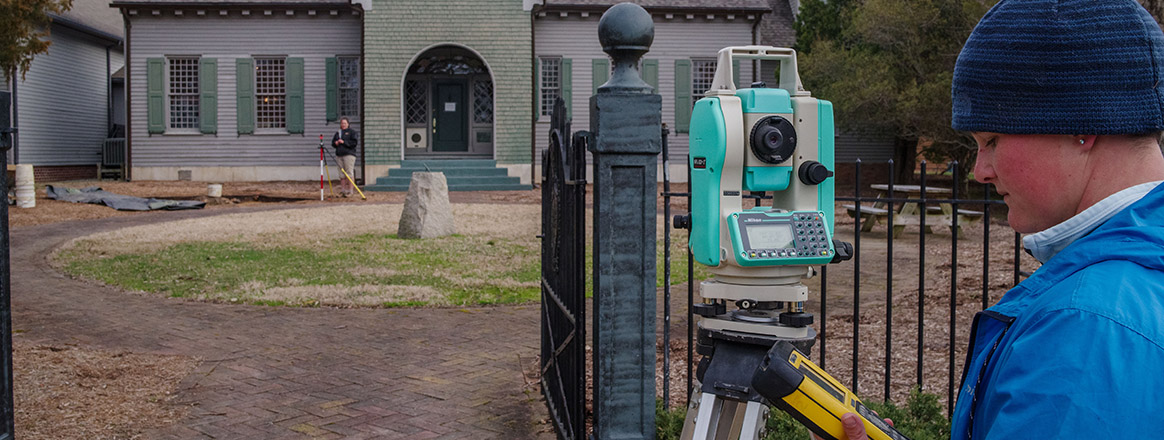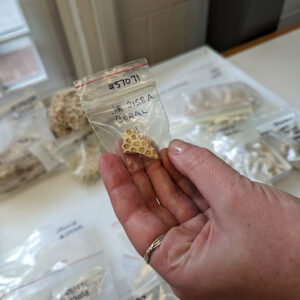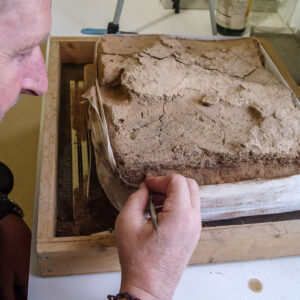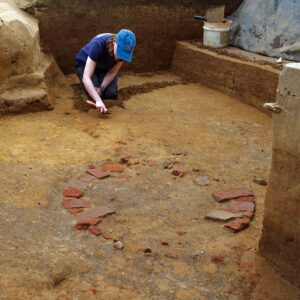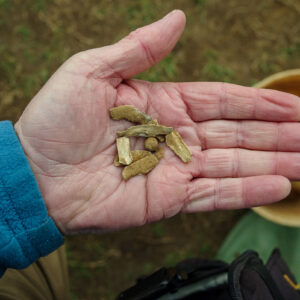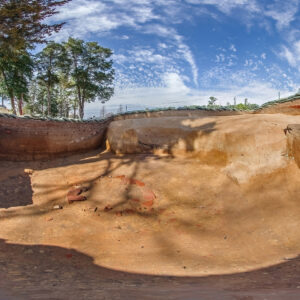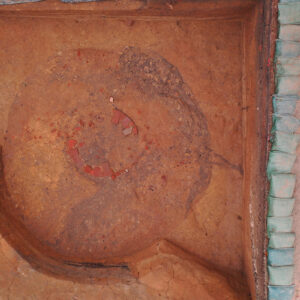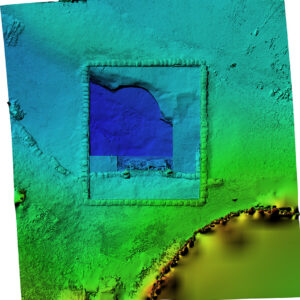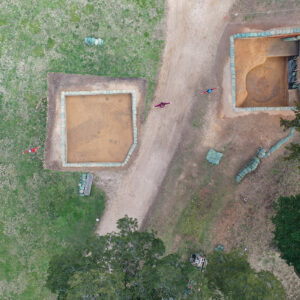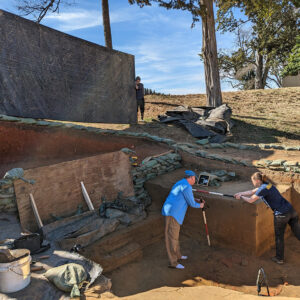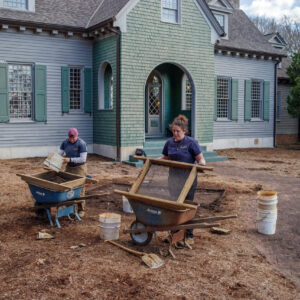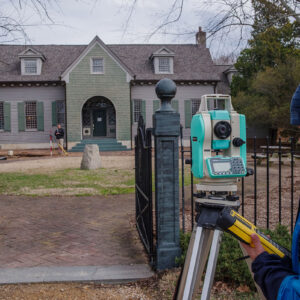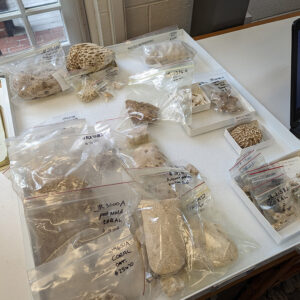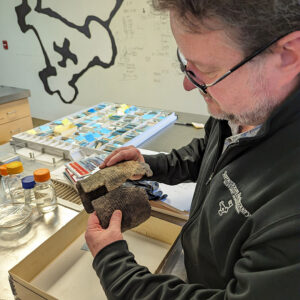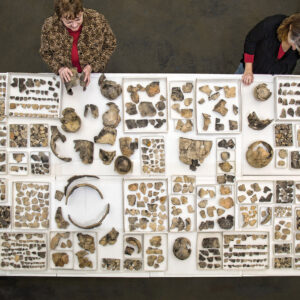Just to the north of James Fort the archaeological team has exposed the entire breadth of an early 17th-century well and its builder’s trench. Meanwhile over at the Jamestown Rediscovery Center, the team is conducting exploratory excavations in preparation for the installation of a garden just outside its front door. Inside the Vault, the curatorial team is continuing its work on the reference collection. This month they have focused their efforts on the hundreds of buttons found since the Jamestown Rediscovery Project’s beginnings nearly three decades ago. The Project’s coral collection is also being classified as part of the reference collection efforts. The curators have been gathering hundreds of bones for research on the eating habits of the colonists and the animals in their midst. In the lab, the conservation team continues their work on the church tower plaster from its collapse during Bacon’s Rebellion. Additionally work continues on a large glass bottle and a Virginia Indian pot that needs additional conservation after a lengthy exhibition in the Archaearium.
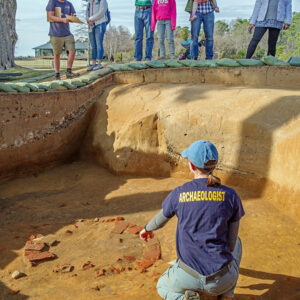
After weeks of slowly shoveling and troweling away soil layers from the 21st through the 17th centuries, the archaeologists have exposed the brick ring and builder’s trench from an early 17th-century well. The next step for the team is to construct a wooden casing that will surround and protect them from any potential collapse of the surrounding soil as they go deeper. This is not new to the archaeological team…they have excavated several other wells in and around James Fort. These prior digs have informed their preparations for the current well. Wells at Jamestown are exciting archaeological features for several reasons, not least of which is the fact that the colonists dumped trash in them once the water was no longer drinkable. 17th-century trash became artifacts, and finds in past wells range from tiny tobacco seeds to iron breastplates. Organic artifacts such as leather shoes, wooden bowls, leaves, and even insects can survive in waterlogged contexts due to the absence of aerobic bacteria. The team is constructing a wooden platform so that visitors can witness the well excavations first-hand. Field Supervisor Anna Shackelford and Staff Archaeologist Natalie Reid recently started excavating a test into a section of the fort-period ditch found north of the well. To date, they have only unearthed a few sherds of Late Woodland Virginia Indian pottery. Additionally, the team is very interested in a posthole found adjacent to the ditch that appears to have been contemporary with it. The purpose of the posthole is yet unknown.
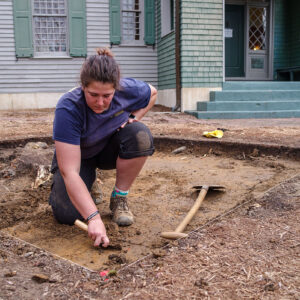
At the Jamestown Rediscovery Center, where many of the project’s staff have offices, a garden is being planned just off the south porch, the latest version of several in this space. The Ellen Kelso Memorial Garden, named after long-time resident of Jamestown, supporter of the project, and wife of Dr. William Kelso, will feature plants appropriate for a 17th-century Virginia garden. But there are issues with digging in this area as there are almost anywhere on Jamestown Island…archaeological features are everywhere. This area in particular is part of the burial ground found beneath the Statehouse foundations, dating the graves to the first half of the 17th century. Gardeners in the mid 20th century discovered evidence of burials here and the team do not want the graves to be disturbed. Accordingly, Archaeologists Caitlin Delmas and Hannah Barch have excavated a 10×10 square to see just how deep is too deep. And the answer is…a bit less than a foot. Archaeological features were discovered at that level in the test square. The excavations indicate that the top soil layers found on other parts of the island are missing here, remarkable but expected for a space that has been used as a garden for decades. The archaeologists will share their findings with the gardeners prior to their work so that their plantings are shallow.
Work is almost complete in the excavations just north of the Church Tower. The last thing the team will do prior to backfilling is run a Ground-penetrating radar (GPR) scan over the portion of the fort’s eastern palisade wall that runs through these excavations. The posthole pattern indicates the presence of a watchtower or guardhouse that connects to the palisade here. Hopefully the GPR will give the archaeologists more insight into this remarkable feature. A few steps away inside the Church Tower the walking platform allowing guests access has been removed briefly in order to prepare a 3D model of the Tower foundation and the foundation of the 1617 church found within the tower’s footprint. They’ll hand this off to the architects so that they can design a floor that won’t negatively impact the archaeological resources beneath it.
In the Vault, Assistant Curator Emma Derry has been busy pulling around 300 bone specimens from the Jamestown faunal collection for a research project investigating what the colonists (and the animals around them) ate over time. Dr. Eric Guiry of the University of Leicester is leading the research and will use isotopic and DNA analysis of the animal bones found in and around James Fort to investigate trends in importing food vs. producing it locally, animal husbandry, and where wild animals were sourced. An excerpt from Dr. Guiry’s proposal:
Based on the premise that you are what you eat and that different foods can have distinctive isotopic compositions, we can analyse collagen extracted from archaeological human and animal bones to assess patterns in the kinds of food eaten, as well as the locations from which those foods were sourced.
The team is excited to be part of Dr. Guiry’s research and will share the results when they become available.

Assistant Curator Janene Johnston has been building upon the work of Intern Ava Geisel by further preparing the Jamestown button collection for inclusion in the reference collection. When it is completed, the Jamestown reference collection will ensure that an example of each type of artifact excavated by Jamestown Rediscovery is easily accessible. This will speed up research for both our team and outside researchers by lessening the need to look through thousands of artifacts or database entries to find what they’re looking for. Should a researcher need to see all examples of a particular type of artifact they could then delve deeper into our archives. Ava has almost finished measuring and sorting the majority of the approximately 900 buttons in our collection. Janene is now cataloging them in our database and choosing examples of each type for the reference collection. There are several instances where the collection only contains one or two examples of a button type, so the reference collection may be quite extensive. Although the majority of the collection is composed of 17th-century buttons, we also have examples through the 20th century. The team plans to do research on the origins of some of the buttons in the collection. A select portion of the buttons will be subjected to minimally-destructive testing to determine chemical composition and give clues as to their place of origin. Prior research has shown that some of our glass doublet buttons were made in Bavaria, Germany.
Curator Leah Stricker has been gathering and identifying corals for use in the reference collection. The different species of coral in the Jamestown collection are largely unidentified and classification is one of Leah’s tasks. Some of the coral may have been used as ballast on the ships coming to Jamestown. Others may have been kept as curiosities by the colonists. Identifying the species may give us insight into where the coral originally lived, perhaps clueing us into the route it (and the ship it arrived on) took on its way to Jamestown. Pairing this with the archaeological context where the coral was found could help narrow the date (and ship) of its arrival even further. None of the corals in the collection show signs of being used as bricks, a practice common in Caribbean colonies.
Senior Conservator Dan Gamble is continuing his work on the church tower plaster. Thought to be part of the wood-framed church tower that burned and collapsed during Bacon’s Rebellion, the plaster was found just to the west of the 1680s Church Tower that replaced it and which still stands today. Dan has removed the soil from one side of the plaster and is now slowly scraping it away from the other. The square where the plaster was found showed extensive signs of burning, with scorched soil and ash above and around the plaster itself. If the plaster is indeed from the tower collapse it would be a rare case of an artifact being tied to a specific date in time. Conservator Dr. Chris Wilkins is treating a Virginia Indian pot that has been on display in the Archaearium. The adhesive holding the sherds of the pot together has weakened and Chris is contemplating the best way forward. The pot’s mount holds the pieces together and it may be that the sherds are displayed in the mount, maintaining the shape of the bowl without actually being adhered to each other. Jackie Bucklew, Conservation Intern, continues to painstakingly piece a large glass case bottle together. The bottle was found in a fort-period cellar inside James Fort’s 1608 addition and is unusual for its sheer size and level of completeness.
dig deeper
related images
- Staff Archaeologist Natalie Reid slowly scraping away soil in the well excavations.
- The team screens soil from the well excavations.
- Window lead and shot from the well/Confederate moat excavations.
- A panorama of the well excavations.
- Archaeological Field Technician Gabriel Brown and Senior Staff Archaeologist Sean Romo prepare a grid for a ground-penetrating radar survey in the well/Confederate moat excavations.
- A drone shot of the well. Note the darker soil circle that marks the boundary of the well’s builder’s trench.
- A digital elevation map of the well/Confederate moat excavations
- Members of the archaeological team mark the path of the early-fort-period ditch as revealed by ground-penetrating radar. The ditch is easily visible in the left (north) square because it has darker soil than that surrounding it. It is also visible in the left portion of the right square before it is cut by the later well and builder’s trench.
- Another perspective of the path of the early-fort-period ditch as marked out by the archaeological team.
- Senior Staff Archaeologist Dr. Chuck Durfor and Staff Archaeologist Natalie Reid prepare a portion of the Confederate moat for a record shot while Archaeological Field Technicians Josh Barber and Gabriel Brown provide shade.
- Staff Archaeologist Caitlin Delmas and Archaeological Field Technician Hannah Barch screen soil excavated from the test square in the Jamestown Rediscovery Center’s garden area.
- Staff Archaeologist Caitlin Delmas and Archaeological Field Technician Hannah use a transit to document the excavations outside the Jamestown Rediscovery Center.
- Some of the coral in the Jamestown collection
- Conservator Dr. Chris Wilkins examines a Virginia Indian pot, the adhesive of which has weakened.
- Some of the Virginia Indian ceramics found at Jamestown
- An early-20th-century photograph of the Yeardley House (Jamestown Rediscovery Center) and garden.


